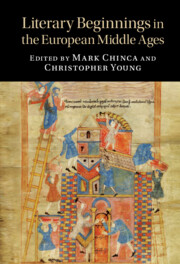Book contents
- Literary Beginnings in the European Middle Ages
- Cambridge Studies in Medieval Literature
- Literary Beginnings in the European Middle Ages
- Copyright page
- Contents
- Contributors
- Acknowledgments
- Foreword
- Chapter 1 Introduction
- Chapter 2 Scandinavia
- Chapter 3 Irish and Welsh
- Chapter 4 English
- Chapter 5 Spain
- Chapter 6 French
- Chapter 7 Dutch
- Chapter 8 Occitan
- Chapter 9 German
- Chapter 10 Italian
- Chapter 11 Czech and Croatian
- Chapter 12 Greek
- Chapter 13 East Slavonic
- Afterword
- Index
- Cambridge Studies in Medieval Literature
Chapter 13 - East Slavonic
Published online by Cambridge University Press: 11 August 2022
- Literary Beginnings in the European Middle Ages
- Cambridge Studies in Medieval Literature
- Literary Beginnings in the European Middle Ages
- Copyright page
- Contents
- Contributors
- Acknowledgments
- Foreword
- Chapter 1 Introduction
- Chapter 2 Scandinavia
- Chapter 3 Irish and Welsh
- Chapter 4 English
- Chapter 5 Spain
- Chapter 6 French
- Chapter 7 Dutch
- Chapter 8 Occitan
- Chapter 9 German
- Chapter 10 Italian
- Chapter 11 Czech and Croatian
- Chapter 12 Greek
- Chapter 13 East Slavonic
- Afterword
- Index
- Cambridge Studies in Medieval Literature
Summary
Early Rus written culture, and eventually literature, developed following the spread of Christianity, which was adopted as the official religion at the end of the tenth century. Christian writings reached Rus in Church Slavonic translation, mainly from Greek originals. Church Slavonic was close enough to local East Slavonic to be treated as the learned register rather than a different language. This learned register was not a closed system. Much Rus writing sticks closely to imported Church Slavonic linguistic and stylistic models, notably in homiletics and in some kinds of hagiography. However, where there is significant local content (in chronicles, for example), there is also more linguistic flexibility across registers. Surviving local compositions are not common. They cannot provide hard evidence of an established culture of literariness. However, they are sufficient to suggest patterns of production in two areas. Prominent among the earliest works are the ‘foundational’ texts whose principal theme is the origins and dignity of Rus itself and of its Christian institutions. Second, a small number of texts hint at a culture of verbal display beyond the devotional, perhaps at court.
Keywords
- Type
- Chapter
- Information
- Literary Beginnings in the European Middle Ages , pp. 276 - 298Publisher: Cambridge University PressPrint publication year: 2022



